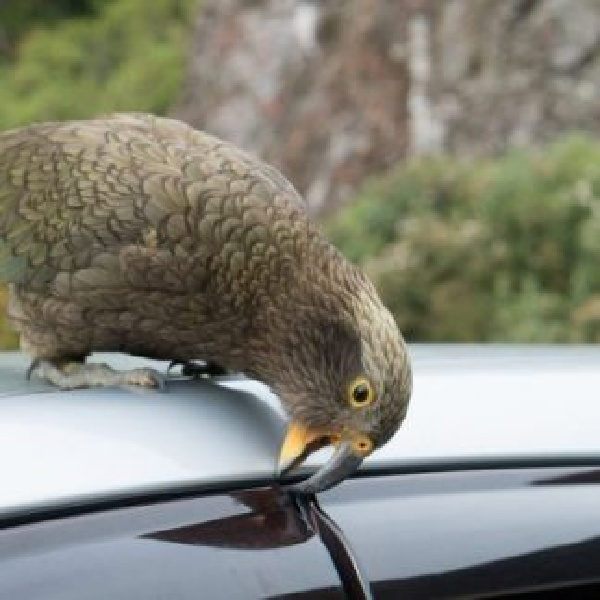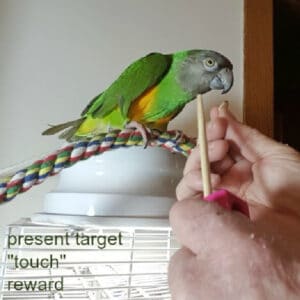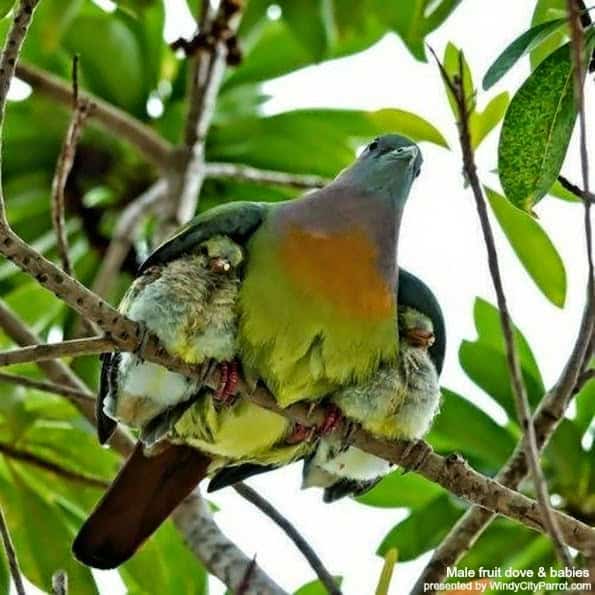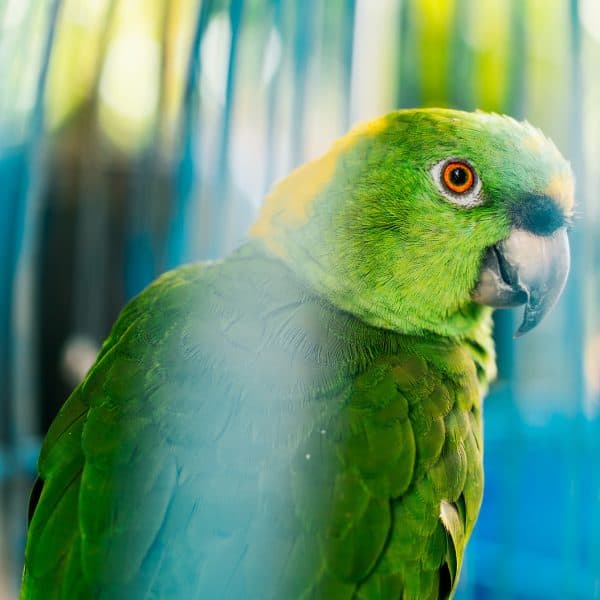
What Are The Most Difficult Parrots To Keep As Pets For Most Bird Owners
Last Updated on by Mitch Rezman
What are the most difficult parrots to keep as pets for most bird owners?
First a little housekeeping.
When we talk about species of birds, it’s important to be specific.
To say that “cockatoos are needy” would be inaccurate.
“Cockatoos like umbrellas and moluccans are needy and affectionate” is more to the point.
Major Mitchell cockatoos are not affectionate birds.
To say that “cockatoos are noisy” can be incorrect.
Cockatoos like umbrellas and moluccans are noisy parrots.
Corella cockatoos are not noisy birds.
And now to the heart of the matter.
I humbly disagree with Dr.Lenhard.
To say that captive birds “cannot eat a diet only of seeds and nuts, because that is completely unbalanced for them and they will end up with all sorts of skin, feather, gastrointestinal, and liver problems” is a problematic statement, at least for me.
Original Quora question: What are the most difficult parrots to keep as pets for most bird owners?
I do agree with her on “Most parrots are fed poorly in captivity”.
I ask rhetorically how do we have hundreds of thousands of “grass parakeets” and budgies surviving on a seed-only diet – for 99 million years?
How did all the Macaws and conures survive for long as they have in South America with no pellet trees?
I have 11 rescue birds, a female Senegal, a male African ringneck and 9 budgies.
But I’m not just the guy who has a lot of birds.
I’ve been running one of the largest websites on the Internet that sells stuff only for birds over the past 15 years.
I interact with 90% of the people who never get the birds into a veterinarian’s office.
I’ve created the title of captive bird environmental specialist – for myself.
She (Dr.Lenhard) talks about birds need to fly which I agree with 100%.
All our birds are flighted.
What needs to be taught is where and how to land which is a counter-intuitive process for them if they had not flown before.
This gets rid of the “breastbone injury problem”.
If I’m giving a bird “flying lessons” I’ll start with using the cage as a landing area.
As an example when we rescued our cockatiel Popcorn she was fully flighted which is why I found her entangled in a bunch of bushes a couple of blocks from the Birdie Boutique, she had escaped from somewhere.
Once I got her home, and then let her out of the cage, she immediately took off.
She ended up bouncing off the wall and falling down in between a wall and an entertainment center.
We decided the best course of action was to clip her wings to help her adjust to her new environment.
Cockatiel’s wings grow back quickly, she was fully flighted in about 90 days.
Editor’s note: Senegal wings grow back much slower than cockatiel wings.
It took Peaches our rescue Sennie about nine months to fully grow back her wings at the age of 8, having been kept clipped since she was six months old.
About 30 days after the wing clip we started to define landing areas.
I’ll always begin with the birdcage because it should be the place your bird is most comfortable within the home.
We added a Booda rope perch, in an inverted “U” position on the top of her cage.
Someplace she could land as well as hang out.
I’ll start at about 1 foot and gently toss the bird towards the target (bird cage) in this case being her own cage.
A cockatiel is a very fast and efficient flyer, they can easily attain speeds of up to 30 mph quite quickly, ergo starting with the 1-foot distance.
At 12 to 18 inches they really can’t attain enough inertia to endure serious body damage.
After two or three tosses, she was landing directly onto the top of the birdcage perch.
Each day I would extend the distance ending at about 20 feet from her birdcage.
She actually taught herself the rest of the landing areas.
She was the first bird I had that would follow me around our 62-foot long apartment and pick appropriate landing areas so that she could be with me in whatever room I would occupy.
That said, you can in fact get parrots with clipped wings to exercise.
Try holding their feet while they wing flap or chase them around a small blank or having them climb the stairs.
Re: “These birds have big beaks made to open nuts, and if they bite you it causes severe pain and in the case of the bigger ones, serious damage!
And they are temperamental, if you displease them in any way you are very likely to get bitten”.
If you get bitten, it’s your own damn fault.
Is important that you learn how to “speak bird”.
As of this writing (10/08/2018), we’ve added a 15-year-old rescue African ringneck to our home about five weeks ago.
Given the opportunity, he will bite your hand so we don’t give him the opportunity.
We also have total control over him using what we call a redirect.
He will do anything to not be separated from one of his favorite bell toys.
By moving the bell toy from his home cage to his travel cage and then from his travel cage to his mother’s home cage, Keto is more than happy to change cages or sit on your hand or arm and be entertained by the bell toy with no biting involved.
As for borrowing a bird, I would never in a million years suggest that somebody borrow a bird.
It could take months if not a year or two for any bird to adjust in a new household, thus any indicators from the bird will be based upon its displacement.
To say that smaller birds are not as expensive as larger birds is misleading.
We spent $3000 treating our (free rescue) cockatiel for cancer treatments.
I agree that you really shouldn’t have a full-time job and leave your bird at home all day.
That said would we rather see the bird in a loving home being part of a family or sitting isolated in a rescue or stressed in a retail environment for most of its life?
Getting a second bird sounds one problem and creates another.
In most cases the second bird will bond with the initial bird and cut the human out of the deal making you a zookeeper rather than a parrot companion.
Well intention-ed caged bird keepers try to recommend the easiest and the hardest birds to keep in this Quora thread.
If keeping birds was so predictable, why are the rescues overflowing with unwanted feathered companions?
I love to use the example of a good friend of ours, Kim.
Kim never had any bird before but she recently acquired a Timneh African grey.
“How dare she start with a gray as her first bird” you say.
What you don’t know about Kim is that she’s run a world-class daycare for 25 years.
In that we defined parrots as basically three-year-old autistic children, in feather suits, what person is better suited to care for such an animal?
A year and the relationship, Zoe has been remarkable interacting with the entire family as well as all the children that come through the home.
She is actually now seeking a second African grey, something we are helping her work through.
I would advocate that avian veterinarians take a deeper dive into bird nutrition because typically I hear the same brands from all the vet’s ” They should eat a balanced pelleted diet like Lafebers, Harrisons, or Roudybush”.
I never hear recommendations for Hagen, Kaylor of Colorado, Scenic or Higgins.
I’m dismissed when I talk about the effectiveness of light therapy versus veterinarian recommendations to introduce terrible drugs like Lupron and Haldol.
If we are to successfully become caged keepers, then we must rethink and redefine our captive bird keeping practices of the last seven centuries.
I will leave you with this video in response to “If you do let them out of a cage, it is usually very difficult to get them to go back in, even for food or bedtime”.
As long as we’re on the subject of how to learn about keeping birds in your home.
Please stop recommending that you need to spend time volunteering in a bird rescue so as to better understand the nature of keeping captive birds.
[videopress WyYwEiTW]
Because when you think about it that’s like saying before you have a child spend some time volunteering in an orphanage before you give birth.
It’s time to end the insanity of captive bird care.
I would recommend that if you think of getting a pet bird, reach out and find someone who has one or more birds in their home and talk to them about daily challenges.
Personally I find the biggest issue is simply keeping our apartment clean be it via brooms and dustpans or vacuuming.
I try to make it not a big issue on a day-to-day basis by feeding our 11 birds using small brush strokes.
I refresh the water in the morning, afternoon and evening.
All three bird cages get bird food feeders and dishes topped off at least twice every 24 hours.
The bigger birds, our Senegal and African ringneck are let out consistently (but separately) throughout the day but with vigilant adult supervision so that nobody but gets injured.
They also commute to work weather permitting.
[videopress kpWnIOzH]
Our nine budgies seem to be immune from any human interaction even when the doors are left open on their large Prevue F050 aviary by accident.
They tend not to take advantage of an escape route because I feel they know they have it really good.
In conclusion, if you’re going to bring birds into your home, expect to have a relationship similar to that having toddlers or children.
There is no way to predict the behavioral outcome of any pet bird.
Over the years we seen both aggressive and cuddly blue and gold macaws.
A parrotlet with no socialization can easily become “a scissors with wings.”
Larger birds without proper training and attention can morph into “flying bolt cutters.”
Two birds as pets may need constant supervision and interaction.
In our home, our Senegal and African ringneck occupy their own cages and the nine budgies have a spacious aviary.
The two birds also travel with us to our permanently parked travel trailer in Indiana almost weekly.
If you do the math you’re looking at three bird cages in our living room, two travel cages, two cages in our shop and two cages in our permanently parked travel trailer bringing the total to nine bird cages necessary to enable our lifestyle.
This means that we have to provide fresh food and water, and keep all the cages clean so the birds remain healthy.
Keeping everything together as an act of love.
This goes way beyond having a dog who happens to have their favorite place to sleep.
We spend our evenings at home, giving the Senegal and African ringneck out of the cage time individually so they don’t crash into each other in flight or bite one another’s toes off.
It’s a work in progress, a strategy that needs development each and every day.
Bringing a bird into your home is not unlike bringing a child into your home.
It’s not like acquiring a dog or a cat because these animals can FLY!
A feathered companion is way more challenging than any mammal kept as a pet.
We’ve seen warm and cuddly blue and gold macaws.
We’ve see aggressive and hostile b&g macaws
A hostile blue and gold macaw is called a “flying bolt cutter.”
An unsocialize parrotlet is nothing more than a “pair of flying scissors.”
As I’ve said repeatedly in the past if you don’t like to vacuum don’t think about getting a bird as a pet as they are very messy animals to have in your home.
If you walk away with anything from this post it should be that you begin to understand that birds process information three times faster than humans.
The question becomes, are you ready to step up?
Author Profile
Latest entries
 The Traveling BirdJune 26, 2025Can You Name 5 Parrot Species That Are Living Wild in the USA?
The Traveling BirdJune 26, 2025Can You Name 5 Parrot Species That Are Living Wild in the USA? Bird BehaviorJune 26, 2025How is it Parrots Are Problem Solvers Social Animals and Even Use Tools?
Bird BehaviorJune 26, 2025How is it Parrots Are Problem Solvers Social Animals and Even Use Tools? Bird & Parrot AnatomyJune 25, 2025How a Tiny Chemical Modification Makes Parrots Nature’s Living Paintings
Bird & Parrot AnatomyJune 25, 2025How a Tiny Chemical Modification Makes Parrots Nature’s Living Paintings PigeonsJune 20, 2025How Do Parrots Thrive in Cities Outside Their Native Habitats?
PigeonsJune 20, 2025How Do Parrots Thrive in Cities Outside Their Native Habitats?
This Post Has 16 Comments
Leave a Reply
You must be logged in to post a comment.




Lisa
14 Oct 2018Thanks, Mitch! Yes, with all the parrots in foster and shelters as you say, I’m amazed that anyone who wants to love a parrot would buy a bred baby instead of taking in one who is already here and needs a home. They need understanding and appreciation of who they are, so what better way is there than getting one where the handlers can already tell you what they are like.
I’ve had mine for almost 30 years, but always scan your articles for good reminders or insights.
WindyCityParrot
16 Oct 201830 years is amazing and a rarity Lisa, Kudos!
Chrischan
16 Dec 2018I think it’s easier for a beginner to get a young bird than to adopt a bird with problems, behavior or health…no built in problems except for having to learn about birds.
Lisa
18 Dec 2018Sadly, the common assumption with all rescue pets is that they come from ‘issues.’ Oftentimes, the owners just couldn’t keep them anymore or passed away. It seems to me, when you look at the majority of books and movies out there, that humans put great value on the transformation of relationships – X and Y get into a situation together, don’t understand each other at all, time and events pass then they find a connection. I’m always surprised that more people don’t see a relationship with an animal the same way! Especially with parrots, who are so subject to being obtained for the wrong reasons and then being rehomed, it seems that our love for them should include advocacy for adopting. Having your own young one isn’t enough education in itself, anyway. There are places and ways to practice being around a parrot before you get one. Just my opinion, no offense meant.
Chrischan
18 Dec 2018I have always adopted from shelters when it comes to cats, but when I got my first bird, I bought a baby since I was afraid to get a bird with issues…knowing not much about them except what I read, I didn’t want to adopt and return. Knowing what I know now, I would adopt a rescue if I were going to add a bird to my mini zoo. I believe I could handle even a tough situation. But it takes knowledge, time and patience to handle even well-adjusted birds. Not everyone is capable.
Lisa
19 Dec 2018From one mini zoo keeper to another, I totally appreciate your perspective. 🙂 Thanks for the dialogue and happy holidays!
Darlene Reinig
14 Oct 2018My first bird, a conure, literally landed on my back while I was out walking my 3 dogs. My husband thought a bat was diving at him, but it was early afternoon so that made no sense. Then I caught the colors flying by and said it appeared to be a bird. As we headed to go inside it landed on my back. Never having had a bird, I was afraid it would peck my face or eyes so avoided looking at it. It refused to leave me so next thing I know I’m buying a cage and food and toys. No one claimed the conure so we kept it. He is a permanent member of my family and he gets along with all of my dogs and cat. He hangs out with me, can fly but chooses to sit with me and talks quite well. I added a budgie, and we are so glad that birds have entered our lives. I never thought I’d own a bird, too messy and not really a pet I thought, but what a different perspective now owning two. So loving, both have great temperaments and personalities, I am so lucky to have them!
Lisa
14 Oct 2018Smart conure! Very sweet story.
WindyCityParrot
16 Oct 2018The universe is too complicated to be arbitrary Darlene
Barbara Begendorf Hardin
14 Oct 2018Good article, Mitch, but I have to disagree with you when you say that Goffin’s cockatoos aren’t noisy. My Goffin’s is extremely noisy. He loves to scream and whine when he doesn’t get his way, and when he isn’t making those noises, he’s talking. Oh, I’m not complaining; I love this bird immensely. He’s like a little child of mine……my little “wild child”……and I wouldn’t give him up for the world. He’s also a velcro bird, which most cockatoos are known to be. I also have a Solomon Island Eclectus, who is an angel compared to my Goffin’s. I love them both. I just don’t want people to get the wrong idea and run out and adopt a Goffin’s cockatoo because they think they are quiet birds, because they are definitely not! Love reading your articles!
WindyCityParrot
16 Oct 2018It’s hard to talk in broad strokes when describing parrots Barbara.
There’s aggressive blue and gold macaws and benign blue and gold macaws.
I hope my points we taken as ‘general” comments.
If we could predict the outcome and behavior of any sing birds, there would be no need for rescues.
Barbara Begendorf Hardin
16 Oct 2018Very true, Mitch. Very true.
Julie
14 Oct 2018HI Mitch,
I always enjoy reading your articles, but I do disagree about leaving for the day to go to work. My first rescue was an African Grey. I happened to walk in to this little pet shop where the owners were going to stick this sick baby bird in the freezer because he was sick and didn’t want to pay for a vet. I was shocked and next thing you know I’m leaving with this baby and heading to see Dr. Sakas. I knew nothing about birds, but did a lot of rescue and rehab with other animals from horses to snakes. Dr Sakas is an amazing teacher. Shortly after that I rescued a B&G Macaw who had been severely abused, had no feathers and hated the world. I worked out of the house for many years and they were on a schedule. So they knew when they were getting fed and getting out of the cage.
Even to this day they’re on a schedule, even though I work from home. They take turns coming into my office for the day and they know when I’m leaving to go out of town for work. I have 5 birds on the same schedule. They respect each others space and generally get along. The African Grey is now 30 years old and has his moods and thinks he’s the boss when the B&G is getting ready to get in trouble, but never messes with the Green Wing.
As far as noise, I think it depends on the home environment. When I’m working they’re usually quiet until they see me. When I rescued the Green Wing she used to scream, and I lived in an apartment in Bensenville. Within a few weeks she was whispering to get my attention and no longer screams except for sunset – all my birds do.
Cage cleaning time, music is going and birds are amped having fun talking and squawking. The Macaws start dancing. As soon as I change the music, they settle down.
All my feathered kids are rescues and have had 25 to 30 years.
My dogs ignore them except for my African Grey. He feels the need to feed them when they’re close and generally throws his food at them.
I’ve lived in the mountains for about 15 years and are doing well, but I think they miss being in the city – so much more to see out their windows.
In the end I think everyone’s situation is different.
Thanks again for your blog!
WindyCityParrot
16 Oct 2018Thank you for the very kind words Julie – and I get it.
Birds take comfort in schedules 🙂
peilers
14 Oct 2018“Many have forgotten this truth,
but you must not forget it.
You remain responsible, forever,
for what you have tamed.”
— Antoine de Saint-Exupery
Being a bird keeper is both a responsibility and a privilege. Thank you Mitch for continuing to educate us all!
WindyCityParrot
16 Oct 2018I try my best peilers